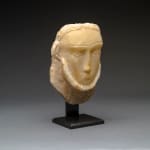Funerary Head of a Bearded Man, 400 BCE - 200 BCE
Calcite-Alabaster
18.4 x 13.2 cm
7 1/4 x 5 1/4 in
7 1/4 x 5 1/4 in
LO.669
Further images
The ancient kingdom of Saba ruled over the lands of southern Arabia, centered in modern day Yemen. Saba is perhaps better known as Sheba, the Hebrew word for the kingdom,...
The ancient kingdom of Saba ruled over the lands of southern Arabia, centered in modern day Yemen. Saba is perhaps better known as Sheba, the Hebrew word for the kingdom, whose famous Queen was recounted as having visited Solomon in the pages of the Old Testament. Biblical accounts speak of the wealth of this ancient civilization of traders and merchants, and modern archaeological excavations confirm these reports. Ruins of fortresses and walled towns are evident and remnants of their extensive irrigation system that turned the desert into a paradise still cover the land. Although gold and silver deposits were present, the chief source of their vast wealth was derived from their veritable monopoly of two of the most coveted materials in ancient times: frankincense and myrrh, resinous gums obtained from certain trees that only grow in Southern Arabia and were literally worth their weight in gold. There was not a temple or wealthy house in the ancient world, from Babylon to Rome, where one would not smell the fragrant scents of these incenses. In addition, a trade route that connected India to Egypt passing through the capital of Marib was another major source of wealth. In the 1st Century A.D., the Ptolemaic Greeks discovered a sea route from India directly to the port of Alexandria, eliminating Saba from her lucrative trade and ushering in the decline of Sabean prosperity.
Portrait of a bearded man, featuring long incised slightly arched eyebrows, elongated eyes, straight vertical nose and small serrated lips, the beard contouring the face ear to ear, the ears, small and perfectly alligned shaped as a semi-circle. The beard is similar to the piece TC 2043 from the Heid bin-Aqil cemetery of Qatabanian Timna. On the chest surface below the beard runs a brief five-letter inscription, presumably a personal name, that (despite the poor lettering) could be translated as Sha'wum. As a name, this is attested once in Safaitic, North-Arabian, though South-Arabian are yet to be found.
The style of some of the letters would place its dating to the 4th-3rd centuries BC.
For a comparable example see R.L.Cleveland, An Ancient South Arabian Necropolis, 1965: pl.21.
For a discussion on the name cf., Harding G.L., Index and Concordance of Pre-Islamic Arabian Names and Inscriptions, Toronto, 1971: p.337.
[Translation and attribution kindly provided by Prof. Kenneth A. Kitchen, University of Liverpool]
Portrait of a bearded man, featuring long incised slightly arched eyebrows, elongated eyes, straight vertical nose and small serrated lips, the beard contouring the face ear to ear, the ears, small and perfectly alligned shaped as a semi-circle. The beard is similar to the piece TC 2043 from the Heid bin-Aqil cemetery of Qatabanian Timna. On the chest surface below the beard runs a brief five-letter inscription, presumably a personal name, that (despite the poor lettering) could be translated as Sha'wum. As a name, this is attested once in Safaitic, North-Arabian, though South-Arabian are yet to be found.
The style of some of the letters would place its dating to the 4th-3rd centuries BC.
For a comparable example see R.L.Cleveland, An Ancient South Arabian Necropolis, 1965: pl.21.
For a discussion on the name cf., Harding G.L., Index and Concordance of Pre-Islamic Arabian Names and Inscriptions, Toronto, 1971: p.337.
[Translation and attribution kindly provided by Prof. Kenneth A. Kitchen, University of Liverpool]





